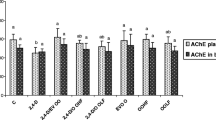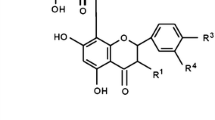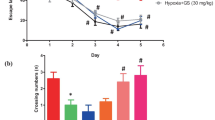Abstract
We investigated how virgin olive oil (VOO) affected platelet and hypoxic brain damage in rats. Rats were given VOO orally for 30 days at 0.25 or 0.5 mL kg−1 per day (doses A and B, respectively). Platelet aggregation, thromboxane B2, 6-keto-PGF1α, and nitrites + nitrates were measured, and hypoxic damage was evaluated in a hypoxia–reoxygenation assay with fresh brain slices. Oxidative stress, prostaglandin E 2, nitric oxide pathway activity and lactate dehydrogenase (LDH) activity were also measured. Dose A inhibited platelet aggregation by 36% and thromboxane B2 by 19%; inhibition by dose B was 47 and 23%, respectively. Virgin olive oil inhibited the reoxygenation-induced increase in lipid peroxidation (57% in control rats vs. 2.5% (P < 0.05) in treated rats), and reduced the decrease in glutathione concentration from 67 to 24% (dose A) and 41% (dose B). Brain prostaglandin E 2 after reoxygenation was 306% higher in control animals, but the increases in treated rats were only 53% (dose A) and 45% (dose B). The increases in nitric oxide production (213% in controls) and activity of the inducible isoform of nitric oxide synthase (175% in controls) were both smaller in animals given VOO (dose A 84%; dose B 12%). Lactate dehydrogenase activity was reduced by 17% (dose A) and 42% (dose B). In conclusion, VOO modified processes related to thrombogenesis and brain ischemia. It reduced oxidative stress and modulated the inducible isoform of nitric oxide synthase, diminishing platelet aggregation and protecting the brain from the effects of hypoxia–reoxygenation.

Similar content being viewed by others
Abbreviations
- cNOS:
-
Constitutive isoform of nitric oxide synthase
- GSH:
-
Reduced glutathione
- GSSG:
-
Oxidized glutathione
- GSHpx:
-
Glutathione peroxidase
- GSHtf:
-
Glutathione transferase
- iNOS:
-
Inducible isoform of nitric oxide synthase
- LDH:
-
Lactate dehydrogenase
- NO:
-
Nitric oxide
- NOS:
-
Nitric oxide synthase
- NO2 − + NO3 − :
-
Plasma nitrite + nitrate
- PGE2 :
-
Prostaglandin E 2
- TxB2 :
-
Thromboxane B2
- TBARS:
-
Thiobarbituric acid reactive substances
- VOO:
-
Virgin olive oil
References
Barzi F, Woodward M, Marfisi RM, Tavazzi L, Valagussa F, Marchioli R, GISSI-Prevenzione Investigators (2003) Mediterranean diet and all-causes mortality after myocardial infarction: results from the GISSI-Prevenzione trial. Eur J Clin Nutr 57:604–611
de Lorgril M, Salen P, Martin JL, Mamelle N, Monjaud I, Touboul P, Delaye J (1996) Effect of a mediterranean type diet on the rate of cardiovascular complications in patients with coronary artery disease. J Am Coll Cardiol 28:1103–1108
Keys A (1980) Seven countries: a multivariate analysis of diet and coronary heart disease. Harvard University Press, Boston
Knoops KT, Groot de LC, Fidanza F, Alberti-Fidanza A, Kromhout D, van Staveren WA (2006) Comparison of three different dietary scores in relation to 10-year mortality in elderly European subjects: the HALE project. Eur J Clin Nutr 60:746–755
Trichopoulou A, Orfanos P, Norat T, Bueno-de-Mesquita B, Ocke MC, Peeters PH, van der Schouw YT, Boeing H, Hoffmann K et al (2005) Modified mediterranean diet and survival: EPIC-elderly prospective cohort study. BMJ 330:991–998
Krauss RM, Eckel RH, Howard B, Appel LJ, Daniels SR, Deckelbaum RJ, Erdman JW Jr, Kris-Etherton P, Goldberg IJ, et al. (2000) AHA dietary guidelines: revision 2000: a statement for healthcare professionals from the nutrition committee of the American heart association. Stroke 31:2751–2766
World Health Organization Study Group (2003) Diet, nutrition, and the prevention of chronic diseases. Geneva, Switzerland. World Health Organization; Technical Report Series 916
McCord JM, Edeas MA (2005) SOD, oxidative stress and human pathologies: a brief history and a future vision. Biomed Pharmacother 59:139–142
Violi F, Cangemi R (2005) Antioxidants and cardiovascular disease. Curr Opin Investig Drugs 6:895–900
Visioli F, Poli A, Gall C (2002) Antioxidant and other biological activities of phenols from olives and olive oil. Med Res Rev 22:65–75
Alexandrova ML, Bochev PG (2005) Oxidative stress during the chronic phase after stroke. Free Radic Biol Med 39:297–316
Guix FX, Uribesalgo I, Coma M, Munoz FJ (2005) The physiology and pathophysiology of nitric oxide in the brain. Prog Neurobiol 76:126–152
Weinbrenner T, Fito M, Farre Albaladejo M, Saez GT, Rijken P, Tormos C, Coolen S, De La Torre R, Covas MI (2004) Bioavailability of phenolic compounds from olive oil and oxidative/antioxidant status at postprandial state in healthy humans. Drugs Exp Clin Res 30:207–212
De La Cruz JP, Villalobos MA, Sedeno G, Sanchez De La Cuesta F (1998) Effect of propofol on oxidative stress in an in vitro model of anoxia-reoxygenation in the rat brain. Brain Res 800:136–144
Bossman HB, Hemsworth BD (1969) Structure and function of nervous system. Academic, London, pp 1–24
Bradford MM (1976) A rapid and sensitive method for the quantitation of microgram quantities of protein utilizing the principle of protein-dye binding. Anal Biochem 72:248–254
Hissin PJ, Hill R (1976) A fluorimetric method of determination of oxidized and reduced glutathione in tissues. Anal Biochem 74:214–226
Flohé L, Gunzler WA (1985) Assays of glutathione peroxidase. Meth Enzymol 105:114–121
Warholm M, Guthenberg C, von Bahr C, Mannervik B (1985) Glutathione transferases from human liver. Meth Enzymol 113:449–503
Lobner D (2000) Comparison of the LDH and MTT assays for quantifying cell death: validity for neuronal apoptosis? J Neurosci Meth 96:147–152
Kelly CM, Smith RD, Williams CM (2001) Dietary monounsaturated fatty acids and haemostasis. Proc Nutr Soc 60:161–170
Freese R, Mutanen M, Valsta LM, Salminen I (1994) Comparison of the effects of two diets rich in monounsaturated fatty acids differing in their linoleic/alpha-linolenic acid ratio on platelet aggregation. Thromb Haemost 71:73–77
Vicario IM, Malkova D, Lund EK, Johnson IT (1998) Olive oil supplementation in healthy adults: effects in cell membrane fatty acid composition and platelet function. Ann Nutr Metab 42:160–169
Turpeinen AM, Pajari AM, Freese R, Sauer R, Mutanen M (1998) Replacement of dietary saturated by unsaturated fatty acids: effects of platelet protein kinase C activity, urinary content of 2,3-dinor-TXB2 and in vitro platelet aggregation in healthy man. Thromb Haemost 80:649–655
Visioli F, Caruso D, Grande S, Bosisio R, Villa M, Galli G, Sirtori C, Galli C (2005) Eur J Nutr 44:121–127
Bartoli R, Fernandez-Banares F, Navarro E, Castella E, Mane J, Alvarez M, Pastor C, Cabre E, Gassull MA (2000) Effect of olive oil on early and late events of colon carcinogenesis in rats: modulation of arachidonic acid metabolism and local prostaglandin E(2) synthesis. Gut 46:191–199
De La Cruz JP, Villalobos MA, Carmona JA, Martín-Romero M, Sánchez de la Cuesta F (2000) Antithrombotic potential of olive oil administration in rabbits with elevated cholesterol. Thromb Res 100:305–315
Moreno JJ (2003) Effect of olive oil minor components on oxidative stress and arachidonic acid mobilization and metabolism by macrophages RAW 264.7. Free Radic Biol Med 35:1073–1081
Nieto N, Torres MI, Ríos A, Gil A (2002) Dietary polyunsaturated fatty acids improve histological and biochemical alterations in rats with experimental ulcerative colitis. J Nutr 132:11–19
Perona JS, Cabello-Moruno R, Ruiz-Gutierrez V (2006) The role of virgin olive oil components in the modulation of endothelial function. J Nutr Biochem 14:429–445
De La Cruz JP, Quintero L, Villalobos MA, Sánchez de la Cuesta F (2000) Lipid peroxidation and glutathione system in hyperlipemic rabbits: influence of olive oil administration. Biochim Biophys Acta 1485:36–44
De La Puerta R, Domínguez ME, Ruíz V, Flavill JA, Hoult JRS (2001) Effects of virgin olive oil on scavenging of reactive nitrogen species and upon nitrergic neurotransmission. Life Sci 69:1213–1222
Villalobos MA, De La Cruz JP, Carrasco T, Smith-Agreda JM, Sanchez de la Cuesta F (1994) Effects of alpha-tocopherol on lipid peroxidation and mitochondrial reduction of tetraphenyl tetrazolium in the rat brain. Brain Res Bull 33:313–318
Visioli F, Bellomo G, Galli C (1998) Free radical-scavenging properties of olive oil polyphenols. Biochem Biophys Res Commun 247:60–64
De La Cruz JP, Martin-Romero M, Carmona JA, Villalobos MA, Sanchez de la Cuesta F (1997) Effect of evening primrose oil on platelet aggregation in rabbits fed an atherogenic diet. Thromb Res 87:141–149
Hünkar T, Aktan F, Ceylan A, Karasu Ç (2002) Effects of cod liver oil on tissue antioxidant pathways in normal and streptozotocin-diabetic rats. Cell Biochem Funct 20:297–302
López-Torres M, Thiele JJ, Sindo Y, Han D, Packer L (1998) Topical application of n-tocopherol modulates the antioxidant network and diminishes ultraviolet-induced oxidative damage in murine skin. Br J Dermatol 138:207–215
Ochoa-Herrera JJ, Huertas JR, Quiles JL, Mataix J (2001) Dietary oils high in oleic acid, but with different non-glyceride contents, have different effects on lipid profiles and peroxidation in rabbit hepatic mitochondria. J Nutr Biochem 12:357–364
O´Bannion MK (1999) cyclooxygenase-2 and Alzheimer’s disease: potential roles in inflammation and neurodegeneration. Expert Opin Investig Drugs 8:1521–1536
Candelario-Jalil E, Gonzalez-Falcon A, Garcia-Cabrera M, Alvarez D, Al-Dalain S, Martinez G, Leon OS, Springer JE (2003) Assessment of the relative contribution of COX-1 and COX-2 isoforms to ischemia-induced oxidative damage and neurodegeneration following transient global cerebral ischemia. J Neurochem 86:545–555
Pepicelli O, Fedele E, Berardi M, Raiteri M, Levi G, Greco A, Ajmone-Cat MA, Minghetti L (2005) Cyclo-oxygenase-1 and -2 differently contribute to prostaglandin E2 synthesis and lipid peroxidation after in vivo activation of N-methyl-d-aspartate receptors in rat hippocampus. J Neurochem 93:1561–1567
Schwab JM, Beschorner R, Meyermann R, Gozalan F, Schluesener HJ (2002) Persistent accumulation of cyclooxygenase-1-expressing microglial cells and macrophages and transient upregulation by endothelium in human brain injury. J Neurosurg 96:892–899
Yermakova AV, Rollins J, Callahan LM, Rogers J, O’Banion MK (1999) Cyclooxygenase-1 in human Alzheimer and control brain: quantitative analysis of expression by microglia and CA3 hippocampal neurons. J Neuropathol Exp Neurol 58:1135–1146
Fang YZ, Yang S, Wu G (2002) Free radicals, antioxidants, and nutrition. Nutrition 18:872–879
Deiana M, Aruoma OI, Bianchi ML, Spencer JP, Kaur H, Halliwell B, Aeschbach R, Banni S, Dessi MA, Corongiu FP (1999) Inhibition of peroxynitrite dependent DNA base modification and tyrosine nitration by the extra virgin olive oil-derived antioxidant hydroxytyrosol. Free Radic Biol Med 26:762–769
D’Angelo S, Manna C, Migliardi V, Mazzoni O, Morrica P, Capasso G, Pontoni G, Galletti P, Zappia V (2001) Pharmacokinetics and metabolism of hydroxytyrosol, a natural antioxidant from olive oil. Drug Metab Dispos 29:1492–1498
Schaffer S, Podstawa M, Visioli F, Bogani P, Müller WE, Eckert GP (2007) Hydroxytyrosol-rich olive mill wastewater protects brain cells in vitro and ex vivo. J Agric Food Chem 55:5043–5049
Martinez-Gonzalez MA (2006) The SUN cohort study (Seguimiento University of Navarra). Public Health Nutr 9:127–131
Ferro-Luzzi A, James WPT, Kafatos A (2002) The high-fat Greek diet: a recipe for all? Eur J Clin Nutr 56:796–809
Bes-Rastrollo M, Sanchez-Villegas A, De La Fuente C, De Irala J, Martinez JA, Martinez-Gonzalez MA (2006) 41:249–256
Covas MI (2007) Olive oil and the cardiovascular system. Pharmacol Res 55:175–186
Martinez-González MA, Sánchez-Villegas A, De Irala J, Marti A, Martínez JA (2002) Mediterranean diet and stroke: objectives and design of the SUN Project. Nutr Neurosci 5:65–73
Acknowledgments
We thank A. Pino Blanes for its excellent technical assistance and K. Shashok for translating parts of the manuscript into English.
Author information
Authors and Affiliations
Corresponding author
Additional information
This study was partially supported by a grant from the Ministerio de Ciencia y Tecnología, Spain (AGL−04-7935-C03-02).
About this article
Cite this article
González-Correa, J.A., Muñoz-Marín, J., Arrebola, M.M. et al. Dietary Virgin Olive Oil Reduces Oxidative Stress and Cellular Damage in Rat Brain Slices Subjected to Hypoxia–Reoxygenation. Lipids 42, 921–929 (2007). https://doi.org/10.1007/s11745-007-3097-6
Received:
Accepted:
Published:
Issue Date:
DOI: https://doi.org/10.1007/s11745-007-3097-6




